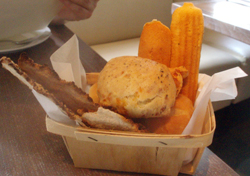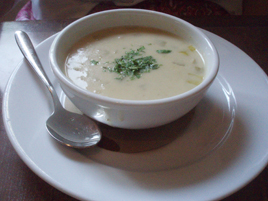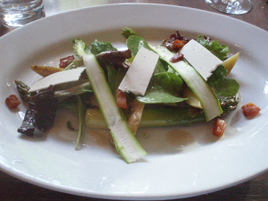Pulino's Bar & Pizzeria
 Monday, May 31, 2010 at 07:27PM
Monday, May 31, 2010 at 07:27PM 

Note: This is a review under Chef Nate Appleman, who left the restaurant in November 2010.
*
Few New York restauranteurs—okay, none—have managed to attract as much giddy anticipation as when Keith McNally opens a new place. He’s on—what is it?—his tenth or fifteenth brasserie, each duly stamped out of a pre-fab mold, and each hailed instantly as if he were doing something new.
The critics have often liked but have seldom adored his restaurants. Frank Bruni wrote a three-star love letter to Minetta Tavern (the only rating above two stars McNally has ever received), but panned Morandi, curiously the McNally restaurant that is least like the others. Those were the only ones that opened during Bruni’s tenure. On this point McNally deserves much credit: he doesn’t shove restaurants hastily out the workroom door. He bides his time, and when he sees gold, he pounces.
I’m less in McNally’s thrall than most people. I wouldn’t have given Minetta Tavern three stars, but I’ve been twice and love it, for what it is. I found Pastis entirely unimpressive, Odeon and Schiller’s both forgettable, though it should be noted I visited them long past their prime. Nevertheless, Schiller’s and Pastis remain packed (I have not checked Odeon lately). I have never been to Balthazar: it’s too difficult to get in, at the hours I would want to go.
 Now comes Pulino’s Bar & Pizzeria, which is right out of McNally’s playbook—but then again, no. It looks and feels like a McNally place, but he lured James Beard honoree Nate Appleman away from San Francisco, to sling pizza on the Bowery.
Now comes Pulino’s Bar & Pizzeria, which is right out of McNally’s playbook—but then again, no. It looks and feels like a McNally place, but he lured James Beard honoree Nate Appleman away from San Francisco, to sling pizza on the Bowery.
(All of McNally’s past chef hires were from New York, and if we can put it so delicately, he seldom chose anyone who presented any threat of running the show. Quick: do the names of any McNally chefs trip off the tongue? That’s right: they don’t.)
The pro reviewers have hammered Pulino’s pizzas, which are made with a thin crust resembling matzo. Of the six pro reviews I checked, not one liked it. For a restaurant that has “pizzeria” in its name, that’s a drawback.

I visited Pulino’s by myself. Given the reviews, I wasn’t going to take a chance on pizza. (The server advised that a hungry solo diner can finish one, but not if you want to try anything else.)
Fortunately, there are many non-pizza items, and you know what? I loved everything I tried. All the food is cooked in two huge wood-burning ovens, which impart a rustic, smoky flavor.
None of the food at Pulino’s will break the bank. Appetizers (various salads, antipasti, proschutti, bruschette) are $8–15, pizzas $9–18 and easily shareable, mains $18–29.


I started with the Fazzoletti (above left), crèpes topped with ricotta, lamb ragu and peccorino: a hearty dish, full of flavor. Tender polpettine (above right), or braised goat meatballs, came in a luscious sauce of honey, black pepper, green garlic, white wine, polenta verde, and almonds.
 I can’t find an online dessert menu, but I think I had the budino di faro pudding topped with dates and goat’s-milk yogurt (left).
I can’t find an online dessert menu, but I think I had the budino di faro pudding topped with dates and goat’s-milk yogurt (left).
What I loved about this food, besides that it was very good and impeccably prepared, is that I haven’t seen these exact dishes at a hundred other places. Now, a pizzeria that can’t make pizza has a real problem, but there’s excellence and even a bit of inventiveness on the rest of the menu.
The cookie-cutter décor, cribbed from other McNally joints, doesn’t deserve any awards. And at a brand new restaurant, I shouldn’t have to contend with a table that wobbles on an uneven surface.
 Restrooms with a shared washroom are another design feature out of McNally’s playbook. In the photo (right), you’ll notice separate doors labeled “women” and “men.” In fact, they lead to the same room, with a sink for washing up, and with toilets behind another set of doors.
Restrooms with a shared washroom are another design feature out of McNally’s playbook. In the photo (right), you’ll notice separate doors labeled “women” and “men.” In fact, they lead to the same room, with a sink for washing up, and with toilets behind another set of doors.
I had read about this, but I presume many guests have not. While I was at the sink, a woman poked her head inside the door, gasped, and quickly backed out. Is this McNally trademark is past its sell-by date?
Pulino’s serves the identical menu for lunch and dinner. I took advantage of a slow work day to visit Pulino’s for a very late lunch, at 1:45 p.m., when it was less than half full. At prime times, I hear it is mobbed and oppressively loud.
If there’s anyone who can survive a slew of terrible reviews, it’s Keith McNally. Really, aside from the wobbly table, I had no complaints about the meal or the service at all. I suspect Pulino’s will remain popular for a long time to come.
Pulino’s Bar & Pizzeria (282 Bowery at Houston Street, NoLIta)
Food: **
Service: *
Ambiance: Not the reason to dine here
Overall: *½






































